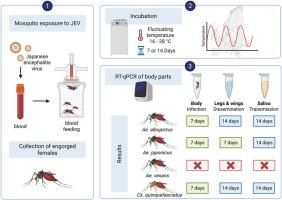Vector competence of European Aedes mosquito species for Japanese encephalitis virus under fluctuating temperature conditions
IF 1.7
Q3 PARASITOLOGY
Current research in parasitology & vector-borne diseases
Pub Date : 2025-01-01
DOI:10.1016/j.crpvbd.2025.100302
引用次数: 0
Abstract
The Japanese encephalitis virus (JEV) is a mosquito-borne flavivirus endemic to much of Asia and the Western Pacific, both temperate and tropical regions. Globalisation and the expansion of invasive mosquito species raise concerns about their potential establishment in Europe and other currently non-endemic regions. However, limited knowledge exists regarding the vector competence of European mosquitoes, particularly under the region’s characteristic fluctuating temperatures. While Culex species are primary JEV vectors, the role of Aedes mosquitoes remains unclear. This study assessed the vector competence of field-caught or low-generation colony-derived Aedes albopictus, Ae. japonicus, and Ae. vexans from Switzerland under a fluctuating temperature regime (16–28 °C), using Culex quinquefasciatus as a reference. Mosquitoes were exposed to JEV genotype I-b and incubated for 7 and 14 days. RT-qPCR was used to analyse mosquito body parts and saliva to determine infection, dissemination, transmission rates and transmission efficiency. Aedes albopictus, Ae. japonicus, and Cx. quinquefasciatus were competent vectors. Aedes japonicus showed the highest infection rate (13.6%, 9/66) compared to Ae. albopictus (3.0%, 3/101) and Cx. quinquefasciatus (6.9%, 7/101), while Ae. vexans was refractory (0/80). Dissemination was observed in Ae. japonicus already 7 days post-exposure, preceding other species. Aedes japonicus had the highest transmission rate (66.7%, 2/3) and efficiency (6.1%, 2/33). This study demonstrates that European Aedes mosquitoes can serve as JEV vectors under fluctuating temperatures and may contribute to virus transmission despite being considered secondary vectors. The findings emphasise that species-specific assessments under realistic temperatures are essential in evaluating the risk of JEV establishment in temperate regions.

温度波动条件下欧洲伊蚊对乙型脑炎病毒媒介能力的研究
日本脑炎病毒(JEV)是一种蚊媒黄病毒,在亚洲和西太平洋大部分温带和热带地区流行。全球化和入侵蚊子物种的扩张引起了人们对它们可能在欧洲和其他目前非流行地区建立的担忧。然而,关于欧洲蚊子媒介能力的知识有限,特别是在该地区特有的波动温度下。虽然库蚊是乙脑病毒的主要媒介,但伊蚊的作用尚不清楚。本研究评估了野外捕获的白纹伊蚊和低代群体来源的白纹伊蚊的媒介能力。黄鳝和黄鳝。以致倦库蚊为参考,在波动温度(16-28°C)下从瑞士采来的威克斯蚊。蚊子暴露于乙脑病毒I-b基因型,孵育7和14 d。采用RT-qPCR方法对蚊虫身体部位和唾液进行分析,确定蚊虫感染、传播、传播率和传播效率。白纹伊蚊;日本,和Cx。致倦库蚊为活性媒介。日本伊蚊感染率最高,为13.6% (9/66);白纹伊蚊(3.0%,3/101);致倦库蚊(6.9%,7/101);Vexans是难治的(0/80)。在伊蚊中有播散。日本血吸虫在暴露后已经7天,领先于其他物种。日本伊蚊传播率最高(66.7%,2/3),传播效率最高(6.1%,2/33)。本研究表明,欧洲伊蚊在温度波动下可以作为乙脑病毒的媒介,尽管被认为是次要媒介,但可能有助于病毒的传播。这些发现强调,在实际温度下进行物种特异性评估对于评估温带地区乙脑病毒建立的风险至关重要。
本文章由计算机程序翻译,如有差异,请以英文原文为准。
求助全文
约1分钟内获得全文
求助全文

 求助内容:
求助内容: 应助结果提醒方式:
应助结果提醒方式:


